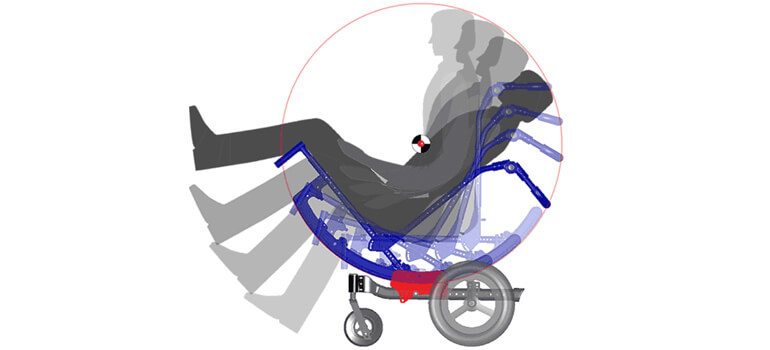Compartir:
¡Descárgalo!
Este recurso de Educación in Motion también está disponible como PDF.
Descargar PDF
Today I will focus on the subject of tilt in space. I was recently asked what is the recommended degree of tilt for an individual for maximal pressure relief? To answer this we must first ask a few questions.
What is tilt in space?
It is where the seat is tilted rearwards in relation to the ground but the seat to backrest angle remains unchanged

Who would need tilt in space?
- Users at high risk of skin breakdown who cannot independently change position
- Users who cannot maintain an upright sitting position against gravity
- Needs specific positions to optimise ADLs e.g. positioning for fatigue management
Why would they need it?
1. Pressure Redistribution:
- Accommodates joint contracture(s)
- Maintains specific seated angles
- Adds no resulting shear forces
- Minimise extensor spasticity
- Maintains access to chair mounted speciality devices
- Safety/stability e.g. downhill driving, van access
2. Assist seated position:
- Minimizes effects of gravity in upright sitting
- Can reduce flexible kyphosis
- Improves visual field (fixed kyphosis)
- Provides increased trunk stability and head control
- Reduces sliding in chair
- Can assist with lower extremity swelling management – with ELRs! (Legs and feet must be 30cm above left atrium)
What does the research say?
According to RESNA (www.resna.org)
For tilt alone:
- >30° Defines a pressure relieving tilt (Sonenblum et al 2008)
- 15°or less No advantage for pressure relief
- 25° Provides shear reduction
- Up to 65° Significant ischial pressure relief
From the research – the more tilt in space that can be provided the greater the level of ischial pressure relief. Beyond 45°, the user's body weight starts to load through the back surface. Whilst pressure under the IT’s reduce, the pressure on the upper part of the pelvis, spine, shoulders and head all increase.
“The greatest reduction in pressures were seen when combinations of tilt and recline were used together, with studies using 25-45° of tilt with 110-150° of recline.” (RESNA Position on the Application of tilt, Recline, and Elevating Legrests for Wheelchairs: 2015 Current state of the Literatures)
We have complete pressure relief for 3 minutes each 30 minutes (Jan et al., 2012 Effect of duration of wheelchair tilt-in-space and recline on skin perfusion over the ischial tuberosity). The tilt should always be greater than recline.
What does that mean?
Backrest should be contoured to match the user's shape to redistribute pressure and support the trunk. This can be done by profiling tension adjustable straps or adding support shapes behind the foam overlay such as those from the JAY J3 backrest ‘Spine Align Kit’.
Key Clinical Message:
Current clinical best practice is that providing a combination of cushion technology with ability to change position (i.e. by using tilt in space) can assist prevention and treatment of pressure ulcers.
So to answer the original question ‘what is the recommended degree of tilt for an individual for maximal pressure relief?'
My advice would be:
- The more tilt in space the better for pressure relief – employed for 15-20 minutes every hour.
- Match it up with an appropriate high pressure relieving cushion – JAY Xtreme Active, JAY Balance, JAY J2, JAY J3 or JAY GS cushion
- Contour the back support for the user – insert foam supports wedges for Solid back supports e.g. JAY Zip, JAY EASY and JAY J3 backs